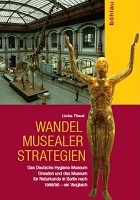Changing museum strategies
The German Hygiene Museum in Dresden and the Museum of Natural History in Berlin after 1989/90 - a comparison

The consequences of the Peaceful Revolution of 1989/90 had a serious impact on all national institutions in the GDR. After a certain period of a state of emergency, museums also had to reestablish their functions and normalize and stabilize as organizations.
This study examines how the Deutsches Hygiene-Museum Dresden and the Museum für Naturkunde Berlin changed institutionally as well as conceptually after 1989/90 and what effects the political changes had on the activities of these two cultural institutions. Specifically, it shows how the actors of the two museums acted and what continuities and breaks emerged from the early 1980s to the late 2000s.
The interdisciplinary study was based not only on the analysis of written sources but also on 30 eyewitness interviews with (former) employees and political decision-makers.
Lioba Thaut works at the Zoological Museum of the Center for Natural History at the University of Hamburg. With "Wandel musealer Strategien" the author published her dissertation in 2017.
- Lioba Thaut (2017): Wandel musealer Strategien. Das Deutsche Hygiene-Museum in Dresden und das Museum für Naturkunde in Berlin nach 1989/90 – ein Vergleich, Wien/Köln/Weimar: Böhlau 2017, ISBN: 978-3-412-509602017-6, 307 pages, www.boehlau-verlag.com

